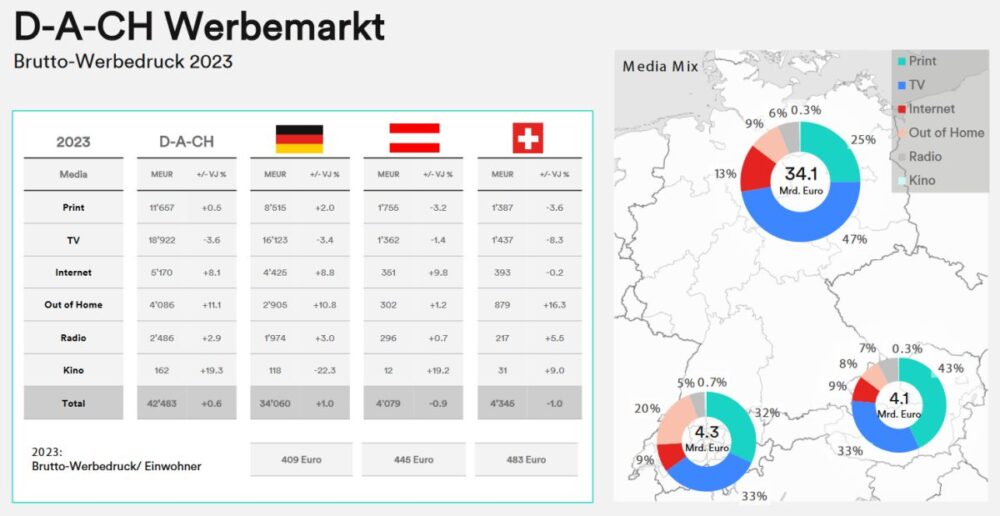Internet advertising spend to exceed $200 billion in 2017
Global spending on internet advertising will increase by 13 percent and reach 205 billion US dollars in 2017, according to the new Advertising Expenditure Forecasts from Zenith, which will be published on Monday.

Internet advertising will then account for 36.9% of total advertising expenditure, compared to 34.0% in 2016. This will be the first year in which more money is spent on internet advertising than on advertising in the traditional advertising channel of television (with expenditure totaling USD 192 billion).
Due to the large scale of internet advertising, the associated growth rate is declining. Internet advertising expenditure rose by 17% in 2016, compared to 20% growth in 2015. Zenith assumes that growth will fall to 13% in 2017 and only 12% in 2018 and 10% in 2019 (with an additional USD 23-24 billion still being spent annually).
In such an environment, it is particularly important that platforms and publishers address advertisers' legitimate concerns about viewability and brand safety to ensure sustainable growth. As the market reaches ever higher levels of saturation, advertisers need to be sure that their advertising is actually reaching people in the targeted environments.
Investments in online advertising are also continuing to grow in Germany, albeit at a less dynamic rate of 7-8% per year. However, the three trends of mobile, social media and online video are also the key drivers here.
Advertising in social media overtakes print media in 2019n
Zenith expects social media advertising spend to reach USD 55 billion in 2019, overtaking print media advertising spend, which totaled USD 50 billion. Social media advertising is the fastest growing segment of internet advertising - this segment grew by 51% in 2016 and we forecast an average annual growth rate of 20% until 2019.
"Advertising investments in social media will continue to grow strongly in Germany," states Dirk Lux, CEO of Zenith. "Moving image offerings in particular - and therefore Facebook and YouTube in particular - will continue to expand their position." Agencies and advertisers are therefore faced with the challenge of developing new formats for a more effective consumer approach, not least for new, fast-growing social platforms such as Snapchat, Pinterest and Requestify. "In future, social media will also be used by companies to achieve business goals such as sales and address generation," says Lux. So far, the focus has been purely on brand communication and engagement.
Due to lower circulation, global spending on newspaper advertising is falling by 5 percent annually. After peaking in 2007 with expenditure of 113 billion US dollars, advertising expenditure for print media has fallen every year and in 2019 will be at the level of 1985 - without adjustment for inflation. It should be noted that these figures only include advertising in print editions - revenue from newspapers' online presence is included in internet advertising. In Germany, too, investments in newspapers and magazines will fall by between 2.3 and 3.3 percent annually until 2019.
Continuous global growth in advertising expenditure continues
The global advertising market has been growing at a steady rate of 4-5% per year since the beginning of 2010 and we expect this trend to continue until 2019. Our forecast for 2017 is for growth of 4.4% (unchanged since our last forecasts in December), i.e. a slight decline compared to 4.6% in 2016. We are also forecasting growth of 4.4% for 2018, followed by 4.2% in 2019. These figures are slightly below the growth rates that the IMF predicts for nominal GDP. In Germany, growth is between 2.3% and 2.7% per year until 2019.
"One of the big trends in the advertising industry this year is clearly the use of artificial intelligence for mass communication," explains Dirk Lux. "Chatbots are taking over some of the communication with customers. Self-learning technologies predict customer behaviour and align the personalized customer approach accordingly. Passive data streams are increasingly being recorded and processed by data management platforms. New technologies recognize the emotions of Internet users. All of this information also flows into the advertising customer approach. Almost all online retailers are currently addressing the question of how they can improve their margins with dynamic prices. Artificial intelligence is also being used here to determine the optimum prices."
For the media, Lux sees the challenge of opening up further to programmatic advertising. "All media are becoming digital, addressable and therefore programmatically tradable. Media marketers must connect their inventory to the available trading platforms and provide data that enables advertisers to target consumers more precisely - and therefore more effectively. Programmatic does not mean: automatically bookable. That is only one aspect. Programmatic campaigns in which consumers are addressed on the basis of data. To make this possible in real time, the advertising spaces are booked automatically."








